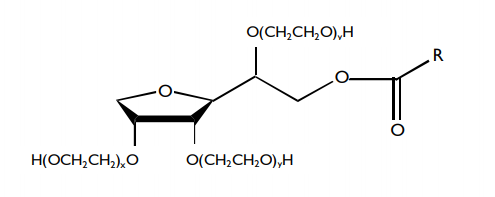Enhanced TDS
Knowde-enriched technical product data sheet
Identification & Functionality
- Chemical Family
- Chemical Name
- Cleaning Ingredients Functions
- CAS No.
- 26266-57-9
- EC No.
- 247-568-8
- Technologies
- Product Families
Features & Benefits
- Labeling Claims
- HII Features
- Product Background
Sorbitan esters and their ethoxylates
Croda's unique expertise in ester technology and continuing commitment to customers has established the company as a world-leader in the supply of sorbitan esters and derivatives for an array of applications. A unique understanding of the highly complex properties and functions of sorbitan esters has been developed to ensure customer developments are cutting edge in today's highly competitive environment.The Spans and Tweens are a range of mild nonionic surfactants providing formulating benefits in a number of Home Care applications. Croda's Span and Tween materials have long-standing food and pharmacopeia approval with a safe history of use.
As nonionics, Spans and Tweens offer many advantages over ionic surfactants including increased stability, formulating flexibility and wider compatibility. They are stable in mild acids, alkalis and electrolytes and do not react with ionic ingredients or actives. By combining Spans and Tweens at different ratios, formulators are able to produce systems with a wide HLB range to emulsify most oils and waxes. Certain Spans and Tweens are also highly effective solubilisers, dispersing agents and wetting aids.
- Functional Benefits
- Nonionic emulsifiers and co-emulsifiers
- Solubilisers
- Dispersants
- Wetting agents
- Stable over a wide pH range
- Electrolyte tolerant
- Span - Sorbitan Esters
Croda's sorbitan esters are marketed under the Span product name and are produced by the dehydration of sorbitol. Esterification with fatty acids in a controlled chemical process gives reproducible materials at the quality expected from Croda. A monoester of a generic Span can be represented as:

Figure 1: Chemical structure - Sorbitan monoester
R is the alkyl group of the fatty acid. Further esterification with fatty acids results in polyesters. The sesqui and triesters contain 1-2 and 3 fatty acid groups respectively. The HLB value of the range decreases with increasing degree of esterification, conferring superior solubility in lipophilic materials.
Applications & Uses
- Markets
- Applications
- Home Care Applications
- I&I Cleaning Applications
- Applications
- Span and Tween surfactants find widespread use in a diverse range of household consumer products and are useful as emulsifers, solubilisers, wetting agents and dispersants.
- Spans and Tweens are recommended as emulsifiers for natural and synthetic waxes and silicone oils to produce low viscosity emulsions e.g. furniture/ multisurface polishes, and shoe polishes.
Properties
- Physical Form
- Partially Soluble in
- Water
- Typical Properties
Value Units Test Method / Conditions HLB Value 6.7 - - - Solubility
Table 1 below provides information on the solubility of the Span™ 40 at 10% w/w in a number of common solvents and oils at 25°C.
Product Name Water Mineral oil Kerosene Rapeseed oil Methyl oleate Butyl Stearate PS G I I I I
Regulatory & Compliance
- Certifications & Compliance
- Biodegradability
Spans are considered to be readily biodegradable and would not be expected to persist indefinitely in the environment. Tweens are considered to be inherently biodegradable and would not be expected to persist indefinitely in the environment.
Packaging & Availability
- Country Availability
- Regional Availability